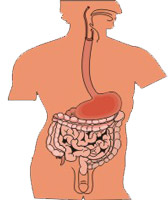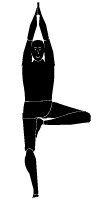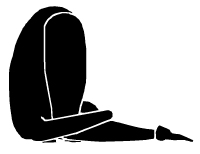Introduction

More commonly, people with appendicitis have any combination of these symptoms. Early symptoms are often hard to separate from other conditions including gastroenteritis (an inflammation of the stomach and intestines). Many people admitted to the hospital for suspected appendicitis leave the hospital with a diagnosis of gastroenteritis; true appendicitis is often mis-diagnosed as gastroenteritis initially. There are no known preventive measures for appendicitis. High fibre diet decreases the bowel transit time and the viscosity of the faeces and reduces the formation of fecaliths that predispose to obstruction of the appendix. The incidence of appendicitis is lower in those with a high intake of dietary fibre.
Yoga and Appendicits
Yoga is primarily a philosophical science, born out of man's need to fathom the meaning of existence. Patanjali, the father of yoga, states in the second sutra "Yoga is the cessation of consciousness." The ultimate aim of yoga is self-evolution. In ancient times, when people lived the yogic way, good health was the natural result of their lifestyle. But, as health deteriorated with man's changing values, yoga gained ground in its use as therapy. Yoga uses postures to correct inner malfunction according to natural principles. It is important to minimize the use of drugs whenever possible and employ natural methods that, in the long run, preserve the sensitivity of the body. Such a body will be more responsive to treatment than one that has been constantly exposed to drugs.The cause of appendicitis relates to blockage of the inside of the appendix. This blockage leads to increased pressure, impaired blood flow, and inflammation. If not treated, gangrene and rupture (breaking or tearing) of the appendix can result. Then again, not everyone with appendicitis exhibits all the symptoms. The pain intensifies and worsens when moving, taking deep breaths, coughing, or sneezing. The area gets very tender. People may have a sensation called downward urge, the feeling that a bowel movement will relieve their discomfort. However, if detected in the early stages, Yoga postures taught with the foundation of optimal body alignment can help and avert surgery. This is because Yoga enables the student to safely achieve maximum benefit from the asanas. In addition, breathing practices are taught and the result is relaxation, personal well-being and spiritual awareness.
YOGA POSES FOR ANXIETY
YOGA POSES FOR APPENDICITIS
Triangle Pose
Energy in the spine increases. It stimulates blood flow and helps to stretch and relax the back, shoulders, legs and arms as well as increases the flow of blood to the head. The muscles of the thighs and calves as well as the hamstrings are stretched. The slight twist of the spine creates suppleness in the spinal discs and relieves lower back discomforts.Supported Head Stand Pose
This posture helps to strengthen your sense of balance and concentration. The arch formed by the back and stretched leg gently aligns the vertebrae of the spine restoring suppleness and easing strain caused by poor posture or long periods of sitting. It tones the muscles of the hips and legs as well as stimulates the chest muscles.Warrior Pose
Warrior III improves balance, memory and concentration, and tones and invigorates the whole body. This pose improves circulation and respiration and energizes the entire body. It improves balance and concentration; builds confidence.YOGA ASANAS FOR APPENDICITIS
VRIKSHASANA

Steps
- Inhale and exhale take both your arms up above your head from the sides and join your palms above the head.
- Lift your heels, stand on your toes and pull your whole body upwards, keeping more weight on the left foot
- Continue breathing normally.
- Use your right hand to lift up the left foot and bring it to rest on the right leg; sole of the foot resting on the right inner thigh.
- Stretch your hands as far up as possible. The more your body is stretched, the easier it is to maintain the balance.
- Keep your sight and mind fixed on an object in front.
- Releasing, exhale and bring both your hands down from the sides.
- Simultaneously, bring your heels to the floor in a normal standing position.
SHASHANKASANA
 This asana strengthens the muscles of the legs and thighs and makes them supple. It tones up the spinal nerves and helps in relieving arthritic pain. It is an excellent asana for digestion.
This asana strengthens the muscles of the legs and thighs and makes them supple. It tones up the spinal nerves and helps in relieving arthritic pain. It is an excellent asana for digestion. Steps
- Sit with legs folded backwards, heels apart, knees and toes together.
- Adjust your hips between the heels (Vajrasana). Slowly raise your arms over the head.
- While exhaling, slowly bend forward and stretch your palms on the floor with abdomen pressing against the thighs.
- Then bring your face downwards and touch the floor with the forehead without raising the buttocks. Inhaling slowly, return to an upright position, reversing the process.
MATSYASANA

Steps
- Sit with your legs fully stretched out. Bend each leg at the knees and place your feet on the other hip joint. Both the heels are adjusted in such a way that each presses the adjacent portion of the abdomen. This forms the foot-lock in a sitting position.
- Bend backwards and, exhaling, rest your weight on the elbows. Push your neck backwards and slightly rise the hip upward thus making an arch of the spine.
- Then, by making hooks of the forefingers, hold your toes on the corresponding side without crossing your arms. This posture should be maintained for some time with slow and deep breathing.
- For reverting to the original position, release the foot-lock and return to the supine position by lowering the arch.
PASCHIMOTTANASANA

Steps
- This posture involves stretching of the posterior muscles of the body.
- While sitting, stretch your legs forward and keep them close to each other. Bend a little forward, make hooks of your fingers and hold the big toes on the respective sides.
- While exhaling, bend forward stretching the trunk along the thighs. Rest your on the knees, which should be kept straight.
- Gradually, the tense muscles can be made supple for securing the complete posture. Inhale and return to the original position
SARVANGASANA

Steps
- Lie on the back quite flat. Slowly raise the legs.
- Lift the trunk, hips, and legs quite vertically. Support the back with the two hands, one on either side. Rest the elbows on the ground. Press the chin against the chest.
- Allow the back-shoulder portion and neck to touch the ground closely. Do not allow the body to shake or move to and fro. Keep the legs straight.
- When the Asana is over, bring the legs down very, very slowly with elegance and not with any jerks.
- In this Asana the whole weight of the body is thrown on the shoulders. You really stand on the shoulders with the help and support of the elbows.
- Retain the breath as long as you can do with comfort, and slowly exhale through the nose.
Diseases Related to Virgo |
||


